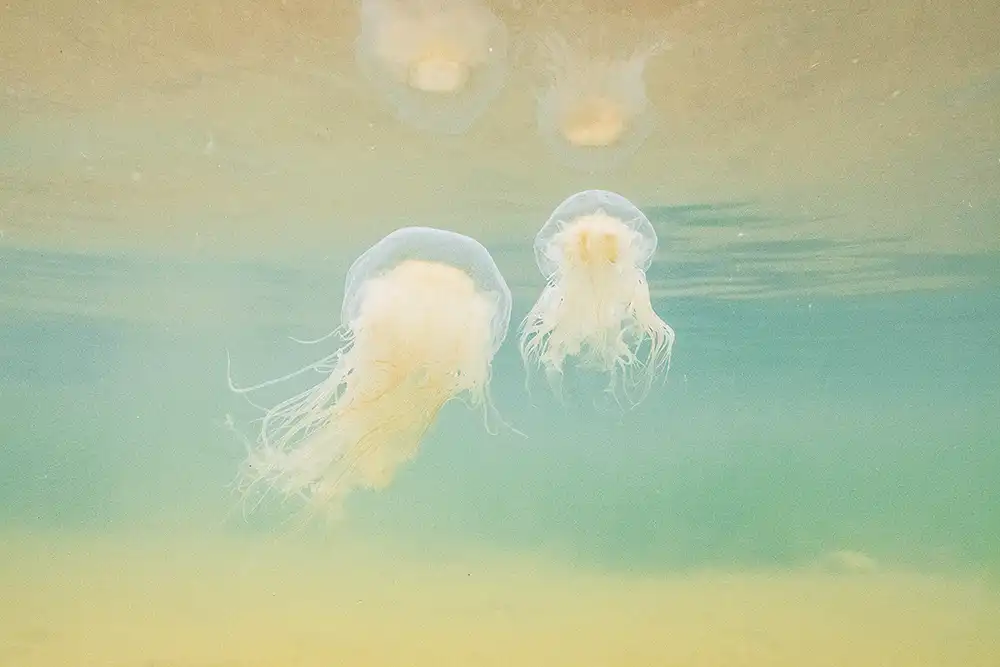
Photographer Rebecca Douglas talks to Joanne O’Brien about her connection to the sea, and the wild edges of the UK coast
Words by Joanne O’Brien, photographs by Rebecca Douglas
The chunk of Kent that protrudes towards continental Europe was once a separate land mass from the rest of that county, and today it is still officially the Isle of Thanet.
A continued sense of ‘otherness’ has contributed to its nickname, ‘Planet Thanet’. Photographer Rebecca Douglas, in her own perception of ‘being different’, chooses to eschew the multicoloured corals and warm-water lifeforms that are flights away, entranced instead by the liminal riches of this edge of the English coastline.
She is not only not even a diver (sleep apnoea) – until recently, she suffered such chronic motion sickness that she could not venture on board a boat. Then a perfect storm of circumstances, involving the Covid lockdowns, a diagnosis of ADHD, and life by the sea, led to her first major solo exhibition celebrating the wild edges of UK coastal environments above and below the water.

Drawn by the unique light she found along the coast, Rebecca started taking photographs while exploring the coast by paddle board and snorkelling. Within two years she had created a body of work that led to her exhibition at the historic sea-facing Albion House Hotel in Ramsgate. It beautifully showcases her unique artist’s eye and the broad range of her style and subject matter.
The images include ethereal moon jellyfish, captured in their filamentous glory at Walpole Bay in Rebecca’s native Margate (notable for its four-acre tidal pool), which at first sight appear to occupy the space between photography and painting.
By contrast, seabirds such as diving gannets make dramatic, imposing subjects – outside her beloved Thanet, the photographer’s other favourite marine environments are RSPB Bempton Cliffs in Yorkshire, and around the Scottish islands, in particular the Shetlands.


Prior to the pandemic, Rebecca, now 40, had a thriving wedding photography business, which she had built alongside a career in education. Growing up in a household where ‘photos and camera kit were part of family life’, her teenage Saturday job had involved developing rolls of film in a newsagent, where the owner allowed her to develop her own film cheaply without having to pay for her experiments that didn’t quite work.
When lockdown hit, the wedding business was booked two years ahead. Everything came to a halt. Supported by her Scottish husband, Mark, as her income plummeted, she started to look for other photographic projects.
‘I don’t take adversity lying down!’
She set about creating a ‘Lockdown Life’ concept, getting permission from the local authority to photograph families and individuals in public places, and outside their homes, as a pictorial record of this moment in their history.
Her photograph of her friends Paul and Simon, at the window of their striking Margate tower block, was chosen as one of the outstanding pictures of the National Portrait Gallery’s nationwide call-out for personal images of lockdown: ‘Hold Still – A Portrait of Our Nation In 2020’, which also became a best-selling book.

Being diagnosed with ADHD and autism at around the same time gave her not just an explanation for why she had often felt disadvantaged by feeling her brain was processing things differently to those of other people, but also of how to recognise her neurodiversity as her advantage.
She realised why she needed to feed her high energy and curiosity, and why she sometimes found it stressful and needed to pace herself; she also discovered that the medication she was prescribed for her ADHD solved her motion sickness and finally allowed her into the water.
She calls herself a ‘coastliner’, protecting the sea a part of her DNA. ‘I love the marine environment at the edges – the spaciousness and the calm, a restlessness, there’s always something moving to rest your gaze upon; what’s lying underneath, what life is like cutting through the surface.

‘I use the drones to see the world from a different perspective, having an expanse of coastline to explore. The waves and
their organic texture are so mesmerising.’
She remembers: ‘People were connected to the sea in Covid, they only needed to put on a pair of swimming goggles. It is nature at arm’s length, and that is what I am most passionate about.
‘We have so much abundance in the coastal zone, under the waters in northern Europe, and I really want to share that with people. There is an enchantment on our doorstep, just beneath the surface.’
Rebecca’s exhibition ‘Wild Edges’ ran for three months during 2024 – to see or buy some of the work from the exhibition, head to rebeccadouglas.co.uk, or follow her on social media on Facebook @rebeccadouglasphotography; X @BxDouglas and Instagram @rebeccadouglasphotography
More great reads from our magazine
- Where Oceans Meet – the amazing biodiversity of Cornwall
- Mexico’s Tren Maya is destroying Yucatán’s cenotes
- Jenny Stock’s guide to getting creative with your underwater photography
- Into the Unknown – scuba diving new sites in Bolsel, Sulawesi
- Nitrogen Narcosis – beware the rapture of the deep



